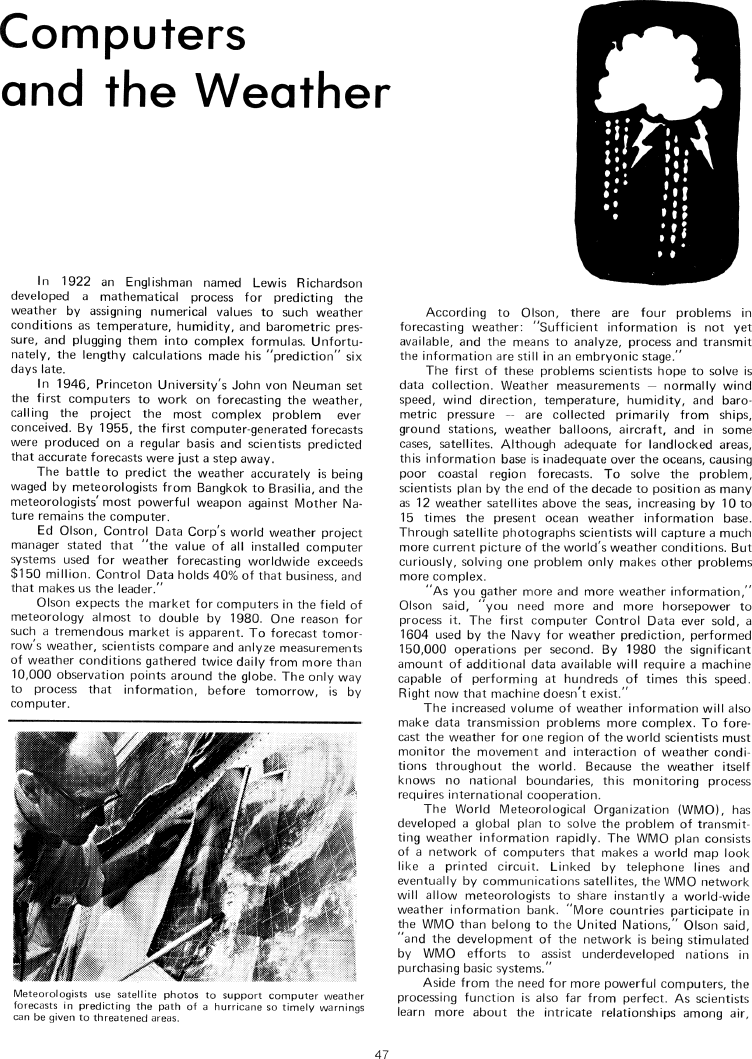The Best of Creative Computing Volume 1 (published 1976)
Computers and the Weather (predicting the weather, meteorology)

Computers and the Weather
ln 1922 an Englishman named Lewis Richardson
developed a mathematical process for predicting the
weather by assigning numerical values to such weather
conditions as temperature, humidity, and barometric
pressure, and plugging them into complex formulas.
Unfortunately, the lengthy calculations made his "prediction" six
days late.
ln 1946, Princeton University's John von Neuman set
the first computers to work on forecasting the weather,
calling the project the most complex problem ever
conceived. By 1955, the first computer-generated forecasts
were produced on a regular basis and scientists predicted
that accurate forecasts were just a step away.
The battle to predict the weather accurately is being
waged by meteorologists from Bangkok to Brasilia, and the
meteorologists' most powerful weapon against Mother
Nature remains the computer.
Ed Olson, Control Data Corp's world weather project
manager stated that "the value of all installed computer
systems used for weather forecasting worldwide exceeds
$150 million. Control Data holds 40% of that business, and
that makes us the leader."
Olson expects the market for computers in the field of
meteorology almost to double by 1980. One reason for
such a tremendous market is apparent. To forecast
tomorrow's weather, scientists compare and anlyze measurements
of weather conditions gathered twice daily from more than
10,000 observation points around the globe. The only way
to process that information, before tomorrow, is by
Computer.
[image]
Meteorologists use satellite photos to support computer weather
forecasts in predicting the path of a hurricane so timely warnings
can be given to threatened areas.
[image]
According to Olson, there are four problems in
forecasting weather: "Sufficient information is not yet
available, and the means to analyze, process and transmit
the information are still in an embryonic stage."
The first of these problems scientists hope to solve is
data collection. Weather measurements - normally wind
speed, wind direction, temperature, humidity, and
barometric pressure - are collected primarily from ships,
ground stations, weather balloons, aircraft, and in some
cases, satellites. Although adequate for landlocked areas,
this information base is inadequate over the oceans, causing
poor coastal region forecasts. To solve the problem,
scientists plan by the end of the decade to position as many
as 12 weather satellites above the seas, increasing by 10 to
15 times the present ocean weather information base.
Through satellite photographs scientists will capture a much
more current picture of the world's weather conditions. But
curiously, solving one problem only makes other problems
more complex.
"As you gather more and more weather information,"
Olson said, "you need more and more horsepower to
process it. The first computer Control Data ever sold, a
1604 used by the Navy for weather prediction, performed
150,000 operations per second. By 1980 the significant
amount of additional data available will require a machine
capable of performing at hundreds of times this speed,
Right now that machine doesn't exist."
The increased volume of weather information will also
make data transmission problems more complex. To
forecast the weather for one region of the world scientists must
monitor the movement and interaction of weather
conditions throughout the world. Because the weather itself
knows no national boundaries, this monitoring process
requires international cooperation.
The World Meteorological Organization (WMO), has
developed a global plan to solve the problem of transmitting
weather information rapidly. The WMO plan consists
of a network of computers that makes a world map look
like a printed circuit. Linked by telephone lines and
eventually by communications satellites, the WMO network
will allow meteorologists to share instantly a world-wide
weather information bank. "More countries participate in
the WMO than belong to the United Nations," Olson said,
"and the development of the network is being stimulated
by WMO efforts to assist underdeveloped nations in
purchasing basic systems."
Aside from the need for more powerful computers, the
processing function is also far from perfect. As scientists
learn more about the intricate relationships among air,


